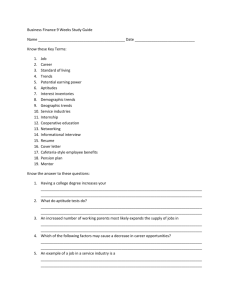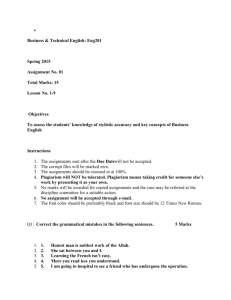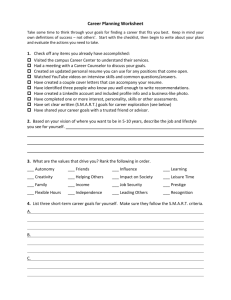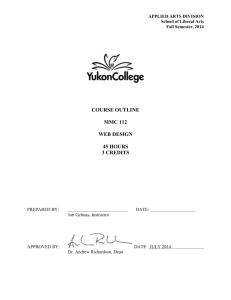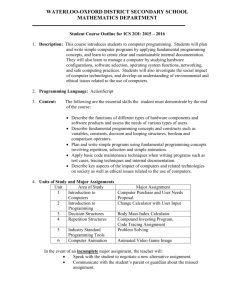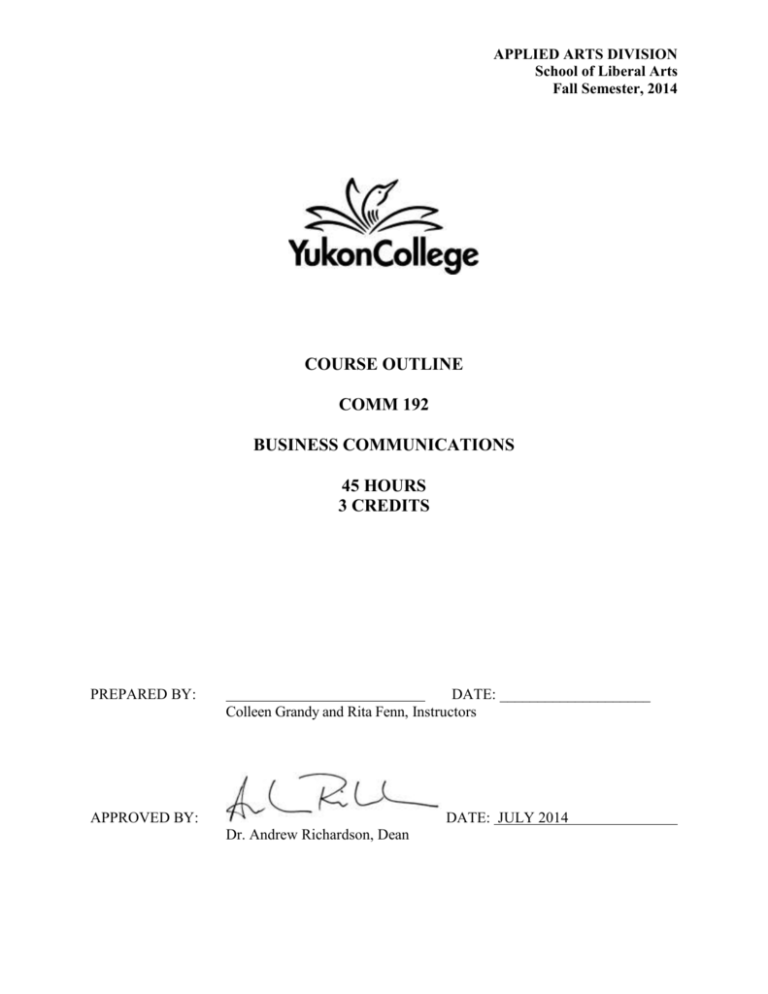
APPLIED ARTS DIVISION
School of Liberal Arts
Fall Semester, 2014
COURSE OUTLINE
COMM 192
BUSINESS COMMUNICATIONS
45 HOURS
3 CREDITS
PREPARED BY:
DATE: ____________________
Colleen Grandy and Rita Fenn, Instructors
APPROVED BY:
DATE: JULY 2014
Dr. Andrew Richardson, Dean
YUKON COLLEGE
Copyright July, 2014
All right reserved. No part of this material covered by this copyright may be reproduced
or utilized in any form or by any means, electronic or mechanical, traded, or rented or
resold, without written permission from Yukon College.
Course Outline prepared by Colleen Grandy and Rita Fenn, July 2014.
Yukon College
P.O. Box 2799
Whitehorse, YT
Y1A 5K4
APPLIED ARTS DIVISION
Business Communications
3 Credit Course
Fall Semester, 2014
BUSINESS COMMUNICATIONS
INSTRUCTOR: Colleen Grandy and Rita Fenn
OFFICE HOURS: By appointment
OFFICE LOCATION: A2404
CLASSROOM: TBA
E-MAIL: cgrandy@yukoncollege.yk.ca
rfenn@yukoncollege.yk.ca
TIME: 7:00-10:00
TELEPHONE: 668-8834
DATES: Thursday
COURSE DESCRIPTION
This course helps students build the proficiency needed to succeed in today’s
technologically enhanced workplace by focusing on the development of professional oral
and written communication skills. Students will improve memo, letter, email, report
writing and presentation skills and the ability to effectively participate in and chair
meetings. Students will also develop skills in resume writing and study the strategies and
techniques needed for success in interviews.
LEARNING OUTCOMES
Upon completion of this course students should be able to:
Write e-mails, memos, and business letters with different tones and for different
purposes
Understand the importance of being an effective business communicator in
today’s changing workplace
Communicate effectively with colleagues in meetings by employing individual
strengths and implementing knowledge of different working styles
Deliver professional oral presentations
Write a polished resume and cover letter and effectively prepare for and
participate in interviews
PREREQUISITES
None
EQUIVALENCY OR TRANSFERABILITY
CAMO
CAMO BUS 130 (3)
CAPU
CAPU CMNS 220 (3)
UFV
UFV CMNS 1XX (3)
UNBC
UNBC COMM 1XX (3)
See B.C. Transfer Guide for any further transfer equivalency.
DELIVERY METHODS
This is mainly a classroom-based course. Topics will be covered through real life
examples that encourage students to work with authentic documents. Written and oral
responses to these documents will be used to facilitate discussion and ground theory in
real world examples. Students are encouraged to use the textbook as a tool to respond to
the case study assignments. The instructor will aim to keep the course material
interactive and varied. In order to cater to a variety of learners, lectures using video, print
visuals, audio, and culminating with group work will be employed along with student-led
seminars.
Email and frequent email access are an important part of this course. The instructor will
communicate through emails and MyYC. The use of MyYC is mandatory and an
orientation will be provided.
REQUIRED TEXTBOOKS/MATERIALS
Guffey, M. E. (2013). Essentials of Business Communication (7th Canadian
Edition).Toronto, Ontario: Nelson.
Computers are available for use at the college labs; it is not required that you own a
computer. However, you will need a USB flash drive to transfer files between computers
and home.
ASSESSMENTS
Assignments
There are seven assignments that make up 70% of the final mark in this course. The
assignments are related to the material covered in class. They will demonstrate the
students’ abilities to apply key course concepts.
Exam
There is one final exam. The exam is cumulative in nature. It will demonstrate student
proficiency in the course material. The exam makes up 20% of the final mark.
Demonstrated Leadership
As students perform specific tasks, they show the instructor and the class that they are
thinking like business communication professionals and improving their understanding of
the discipline.
Students may earn 10 percent for “Demonstrated Leadership” if they:
1. Participate regularly in class.
2. Complete homework assignments.
3. At the end of the class, submit a short email to the instructor explaining why
they should get the 10 percent credit for demonstrating leadership. Students must
also submit the course grade they think they have earned.
Attendance
Success in this course depends on attendance. It is the student’s responsibility to take
notes, to obtain missed assignments, announcements or material handouts for any classes
he/she misses.
Late Assignments
Late assignments will have 5% deducted for every week they are late. They will not be
accepted more than one week after the due date. Please type all assignments.
EVALUATION
Assignment/ Exam Breakdown
Assignment 1: Reflection Paper A
Assignment 2: Routine Writing
Assignment 3: Persuasive/Bad News Writing
Assignment 4: Reflection Paper B
Assignment 5: Oral Presentation
Assignment 6: Cover Letter/ Resume
Assignment 7: Interview
Demonstrated Leadership
Final Exam
TOTAL
% of Final Mark
10%
10%
10%
10%
10%
10%
10%
10%
20%
100%
PLAGIARISM
Plagiarism is a serious academic offence. Plagiarism occurs when students present
the words of someone else as their own. Plagiarism can be the deliberate use of a
whole piece of another person’s writing, but more frequently it occurs when students
fail to acknowledge and document sources from which they have taken material.
Whenever the words, research or ideas of others are directly quoted or paraphrased,
they must be documented according to an accepted manuscript style (e.g., APA,
CSE, MLA, etc.). Resubmitting a paper which has previously received credit is also
considered plagiarism. Students who plagiarize material for assignments will receive
a mark of zero (F) on the assignment and may fail the course. Plagiarism may also
result in dismissal from a program of study or the College.
ACADEMIC ACCOMODATION
Reasonable accommodations are available for students requiring an academic
accommodation to fully participate in this class. These accommodations are
available for students with a documented disability, chronic condition or any other
grounds specified in section 8.0 of the Yukon College Academic Regulations
(available on the Yukon College website). It is the student’s responsibility to seek
these accommodations. If a student requires an academic accommodation, he/she
should contact the Learning Assistance Centre (LAC) at (867) 668-8785 or
lassist@yukoncollege.yk.ca.
WRITING CENTRE
All students are encouraged to make the Writing Centre a regular part of the writing
process for coursework. Located in C2231 (adjacent the College Library), the Writing
Centre offers half-hour writing coaching sessions to students of all writing abilities.
Coaching sessions are available in person and through distance technologies (e.g., email
plus Skype or phone). For further information or to book an appointment, visit the
Centre's website: www.yukoncollege.yk.ca/student_info/pages/writing_centre.
ACADEMIC COURSE CALENDAR DESCRIPTION
Business Communications helps students build the proficiency needed to succeed in
today's technologically enhanced workplace by focusing on the development of
professional oral and written communication skills. Students will improve memo, letter,
email, report, proposal writing and presentation skills and the ability to effectively
participate in and chair meetings. Students will also develop valuable skills in resume
writing and job application and interview strategies and techniques.
SYLLABUS
Date
Week 1
Sept. 4
Week 2
Sept. 11
Week 3
Sept. 18
Week 4
Sept. 25
Topic
Introduction to Business Communication and
The Writing Process: Before You Write
p. 1-11, Chapter2
Introductions/ Goal Setting
Orientation to the MMC Lab
Introduction to MyYC
Communication in the workplace today
Technology in business communication
Understand that business writing should
be audience-oriented, purposeful, and
economical
Identify and implement the three phases of
the writing process
Create messages that highlight audience
benefits and use the “you” view
The Writing Process: Writing and Revising
Chapters 3
Follow the “Seven Tips” for effective
business writing
Organize information into outlines
Compare direct and indirect patterns for
organizing ideas
Identify components of complete and
effective sentences
Revise messages to achieve conciseness,
clarity, and visual persuasiveness
Describe effective techniques for
proofreading routine and complex
documents
Routine Writing: Emails, IMs, Memos
Chapter 4
Know when to send and how to organize
emails and memos
Describe appropriate formats of emails
and memos
Identify smart email practices and
netiquette
Explain benefits and risks of using IM
professionally
Write information, procedure, request, and
reply emails and memos
Routine Writing: Letters
Chapter 5
Explain why business letters are important
in delivering positive messages outside an
organization
Assignments
Assignment #1:
Reflection Paper A
Assignment #2:
Routine Writing
Week 5
Oct. 2
Week 6
Oct. 9
Week 7
Oct. 16
Week 8
Oct. 23
Write letters that request, reply, claim, and
promote goodwill
Persuasive Writing and Writing Negative
Messages
Chapters 6, 7
Use the indirect strategy to persuade
Request favours persuasively
Write convincing claim requests
Present persuasive new ideas
Describe a plan for resolving business
problems
List the four parts of an indirect bad-news
message
Distinguish between the direct and the
indirect pattern for business messages
Apply the indirect pattern in refusing
requests, refusing claims, and announcing
bad news to customers and employees
Be aware of ethical implications of using
the indirect strategy
Reporting Data
Chapter 8, 9
Describe business report basics, including
functions, organization, formats, and
delivery methods
Identify six kinds of informal reports
Write informal informational and
analytical reports
Identify and explain the parts of informal
and formal proposals
Collect data from secondary sources
Understand how to locate and evaluate
date
Understand the need for accurate
documentation and the consequences of
plagiarism
Take MBTI
Face-to-Face Communication: MBTI
Handouts
Analyze personal MBTI results and
discuss how results impact communication
Participate in communication workshop
Face-to-Face Communication: Culture and
Communication, Active Listening, Nonverbal
Communication
p. 12-22
Explain how culture affects
communication and describe methods for
Assignment #3:
Persuasive and Bad News
Writing
improving cross-cultural communication
Identify specific techniques that improve
effective communication among diverse
workplace audiences
Discuss how to become an effective
listener
Analyze nonverbal communication and
explain techniques for improving
nonverbal communication skills
Face-to-Face Communication: Difficult
Conversations, Working in Groups, Managing
Meetings
p. 274-275, p. 286-298, p. 306-307
Review techniques for offering
constructive criticism, responding
professionally to workplace criticism, and
resolving workplace conflicts
Explain how to promote positive
workplace relations through conversation
Follow procedures for planning and
participating in productive professional
meetings
Oral Presentations
Chapter 11
Discuss two important steps in preparing
effective oral presentations
Explain presentation organization
Identify techniques for gaining audience
rapport
Discuss types of visual aids
Student Presentations
Week 9
Oct. 30
Week 10
Nov. 6
Week 11
Nov.13
Week 12
Nov. 20
Week 13
Nov. 27
Communicating For Employment: Resumes
and Cover Letters
Chapter 12
Compare and contrast chronological,
functional, and combination resumes
Organize and format the parts of a resume
to produce a persuasive product
Identify techniques that prepare a resume
for computer scanning, faxing, and
emailing
Write a targeted, persuasive cover letter to
accompany your resume.
Communicating For Employment: Interviews
Chapter 13
Describe what to do before an interview
to make an impressive initial contact
Assignment #4:
Reflection Paper B
Assignment #5:
Oral Presentations
Assignment #6:
Cover Letter and Resume
Week 14
Dec. 4
TBD
Explain how to prepare for interviews
including researching the target employer
Recognize how to control nonverbal
messages and fight interview fears
Be prepared to answer common interview
questions
Communicating For Employment and Review
Exam Review
In-Class Interviews
Interview Analysis
Final Exam
Assignment #7:
Job Interview

